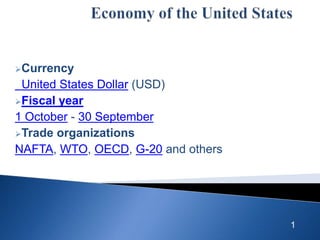
country Lecture 6 economy of the usa
- 1. Currency United States Dollar (USD) Fiscal year 1 October - 30 September Trade organizations NAFTA, WTO, OECD, G-20 and others 1
- 2. GDP $14.441 trillion (2008)[1] GDP growth 0.4% (2008) -3.9% (Q2 2008-Q2 2009)[1] GDP per capita $47,422 (2008)[2] (10th) GDP by sector agriculture (0.9%), industry (20.6%), services (78.5%) Inflation (CPI) -1.4% (June 2008-09)[3] 2
- 3. Population below poverty line 13.2% (2008) Labor force 155 million (includes unemployed) (2008) Labor force by occupation managerial and professional (35.5%), technical, sales and administrative support (24.8%), services (16.5%), manufacturing, mining, transportation, and crafts (24%), farming, forestry, and fishing (0.6%) (excludes unemployed) (2007) Unemployment 9.8% (October 2009) 3
- 4. Main industries petroleum, steel, motor vehicles, aerospace, telecommunications, chemicals, creative industries, electronics, food processing, consumer goods, lumber, mining, defense 4
- 5. Exports $1.283 trillion f.o.b. (2008) Export goods industrial supplies, 29.8%; production machinery, 29.5%; non-auto consumer goods, 12.4%; motor vehicles and parts, 9.3%; food, feed and beverages, 8.3%; aircraft and parts, 6.6%; other, 4.1%. (2008) Main export partners Canada, 21.4%; Mexico, 11.7%; China, 5.6%; Japan, 5.4%; Germany, 4.3%; United Kingdom, 4.1%.[7] Imports $2.115 trillion c.i.f. (2008) Import goods non-auto consumer goods 23.0%; fuels, 22.1%; production machinery and equipment, 19.9%; non-fuel industrial supplies, 14.8%; motor vehicles and parts, 11.1%; food, feed and beverages, 4.2%; aircraft and parts, 1.7%; other 3.2%. (2008) 5
- 6. Import goods non-auto consumer goods 23.0%; fuels, 22.1%; production machinery and equipment, 19.9%; non-fuel industrial supplies, 14.8%; motor vehicles and parts, 11.1%; food, feed and beverages, 4.2%; aircraft and parts, 1.7%; other 3.2%. (2008) Main import partners China, 16.9%; Canada, 15.7%; Mexico, 10.6%; Japan, 7.4%; Germany, 7.4%.[7] Gross external debt $13.77 trillion (30 June 2008) 6
- 7. Public debt $11.4 trillion (June 2009) 81% of GDP Revenues $2.523 trillion (2008) Expenses $3.150 trillion (2008) Economic aid $19 billion, 0.2% of GDP (2004) 7
- 8. The economy of the United States is the largest national economy in the world in both actual dollars and by Purchasing Power Parity.[12] Its nominal gross domestic product (GDP) was estimated as $14.4 trillion in 2008, which is about three times that of the world's second largest economy, Japan. Its GDP by PPP is almost twice that of the second largest, China. 8
- 9. The U.S. economy maintains a very high level of output per person (GDP per capita, $47,422 in 2008, ranked at around number ten in the world). The U.S. economy has maintained a stable overall GDP growth rate, a low unemployment rate, and high levels of research and capital investment funded by both national and, because of decreasing saving rates, increasingly by foreign investors. In 2008, consumer spending made seventy-two percent of the economic activity in the U.S. 9
- 10. Since the 1970s, the United States economy has absorbed savings from the rest of the world. The phenomenon is subject to discussion among economists. Like other developed countries, the United States faces retiring baby boomers who have already begun withdrawing from their Social Security accounts; however, the American population is young and growing when compared to Europe or Japan. The 2008 estimates of the United States public debt by the CIA Factbook and the International Monetary Fund were 61% of GDP, about the same as major European countries. 10
- 11. The United States has been one of the best-performing developed countries, consistently outperforming European countries. The American labor market has attracted immigrants from all over the world and has one of the world's highest migration rates. Americans have the second highest income per hour worked.[16] The United States is ranked second, down from first in 2008-2009 due to the economic crisis, in the Global Competitiveness Report 11
- 12. An economy is the ways in which people use their environment to meet their material needs. It is the realized economic system of a country or other area. It includes the production, exchange, distribution, and consumption of goods and services of that area. The study of different types and examples of economies is the subject of economic systems. A given economy is the end result of a process that involves its technological evolution, history and social organization, as well as its geography, natural resource endowment, and ecology, among other factors. These factors give context, content, and set the conditions and parameters in which an economy functions. 12
- 13. Today the range of fields of study exploring, registering and describing the economy or a part of it, include social sciences such as economics, as well as branches of history (economic history) or geography (economic geography). Practical fields directly related to the human activities involving production, distribution, exchange, and consumption of goods and services as a whole, range from engineering to management and business administration to applied science to finance. All kind of professions, occupations, economic agents or economic activities, contribute to the economy. Consumption, saving and investment are core variable components in the economy and determine market equilibrium. There are three main sectors of economic activity: primary, secondary and tertiary. 13
- 14. The word "economy" can be traced back to the Greek word "one who manages a household", derived from οἴκος, "house", and νέμω, "distribute (especially, manage)". From οἰκονόμος "of a household or family" but also senses such as "thrift", "direction", "administration", "arrangement", and "public revenue of a state". The first recorded sense of the word "economy", found in a work possibly composed in 1440, is "the management of economic affairs", in this case, of a monastery. Economy is later recorded in other senses shared by οἰκονομία in Greek, including "thrift" and "administration". The most frequently used current sense, "the economic system of a country or an area", seems not to have developed until the 19th or 20th century. 14